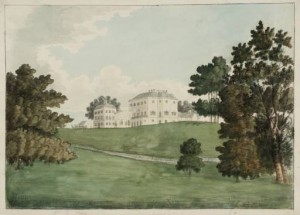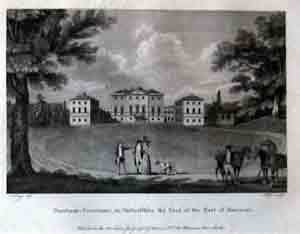Nuneham Courtenay – A Regency example of Trip Advisor?
These days if we plan to visit a tourist attraction there are plenty of books and websites giving reviews of the place and all it has to offer. I had assumed that this was a relatively modern phenomenon until I read about the Nuneham Courtenay experience.
assumed that this was a relatively modern phenomenon until I read about the Nuneham Courtenay experience.
The mansion and flower garden at Nuneham Courtenay, eight miles south east of Oxford, was created by the 1st Earl Harcourt, (1714 – 1777) and his son the 2nd Earl Harcourt (1736 – 1809). There is some very interesting history about the building of the house here. The 2nd Earl was a friend of the French philosopher Rousseau and quite a political radical. He removed the coronets from his coaches and gave away the ancestral paintings. He also employed Capability Brown to enhance the landscape around his house. Between 1778 and 1781 the park was turned into an idealised landscape with a hanging wood, lush meadows and a country view. It was visible from the River Thames and one of the best ways to view the gardens was by boat. The Nuneham Park Fair, which the family established in the gardens during the 1770s was a very popular local event.
The 2nd Earl's revolutionary inclinations mellowed into a benign paternalism over the years and he decided to be more egalitarian by opening up his parkland and flower gardens to the public. Two thatched cottages beside a lock on the river at Nuneham Dingle provided refreshments for visitors, including cold meats, tarts, cake and fruit with port, sherry, champagne and bitter ale to drink.
 The gardens were open from May to September, much as many stately homes are now, and they proved a popular place to visit. A Visitors' Book from 1815 – 1825 records the impressions of a number of people. Unfortunately, just as in the present, not all reviewers were kind. There were quite a few students and academics who would make the trip out from Oxford, get "drunk as lords" at the refreshment cottage and then write rude comments or naughty rhymes in the book. One commenter calling himself "David Doggerel" wrote in 1817:
The gardens were open from May to September, much as many stately homes are now, and they proved a popular place to visit. A Visitors' Book from 1815 – 1825 records the impressions of a number of people. Unfortunately, just as in the present, not all reviewers were kind. There were quite a few students and academics who would make the trip out from Oxford, get "drunk as lords" at the refreshment cottage and then write rude comments or naughty rhymes in the book. One commenter calling himself "David Doggerel" wrote in 1817:
"Well does the dinner and the day agree, the dishes are all cold and so are we."
Lord and Lady Harcourt did not hold back in responding. Not for them the gracious reply or a discreet ignoring of critical remarks! Offending comments were either erased, torn out of the book, or the Harcourts would retaliate with sarcasm. On one occasion they wrote:
"All ladies and gentlemen who are ambitious to perpetuate their names by inserting them in the book should first learn how to spell them and if possible write legibly so that Lord and Lady Harcourt may at least have the felicity of knowing whom they accommodate."
There were of course more august visitors as well as the common crowd; In 1780 King George III visited Nuneham, as did the Archduke of Austria. In 1815 Warren Hastings, one time Governor General of India, visited. So did the Governor of Oxford Castle. These were treated as very special visitors, given a private tour and accommodated at the house. Lord Harcourt still had a respect for rank and consequence!
According to the Visitors' Book most tourists were fairly local and all arrived by boat from Abingdon and Oxford. As early as 1815, Nuneham was the focus of several "works outings." An Oxford company, Wyatt's, arranged a trip for their employees that year. In 1817 the employees of Speakman and Fisher, a tailoring company, came out on a day trip and in 1824 Coles' Coachmakers paid a call. In 1818 the Berkshire Yeomanry day trip ended in acrimony when the soldiers became very drunk. Other visitors disapprovingly referred to them in the book as "drunken dogs."
was the focus of several "works outings." An Oxford company, Wyatt's, arranged a trip for their employees that year. In 1817 the employees of Speakman and Fisher, a tailoring company, came out on a day trip and in 1824 Coles' Coachmakers paid a call. In 1818 the Berkshire Yeomanry day trip ended in acrimony when the soldiers became very drunk. Other visitors disapprovingly referred to them in the book as "drunken dogs."
Other entertainment on offer included rowing and fishing on the Thames and in hot summers men would apparently bathe naked in the river! Some visitors commented unfavourably on the gardeners and greenkeepers who, on one occasion, threatened to shoot the ladies for walking on the grass before it had been cut. All in all it sounds as though Nuneham was a very entertaining day out!
Later the landscape park featured in several of the Alice in Wonderland stories by Lewis Carroll.
©2012 Nicola Cornick. All Rights Reserved.
.


